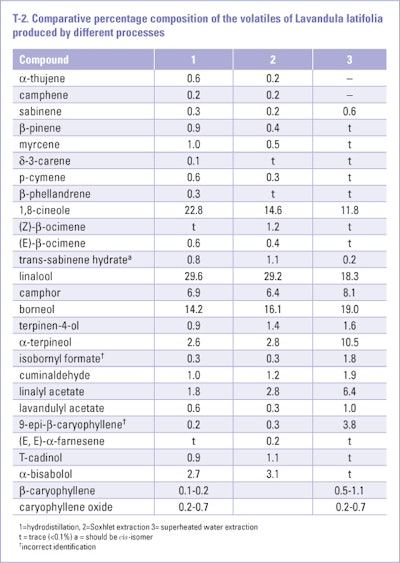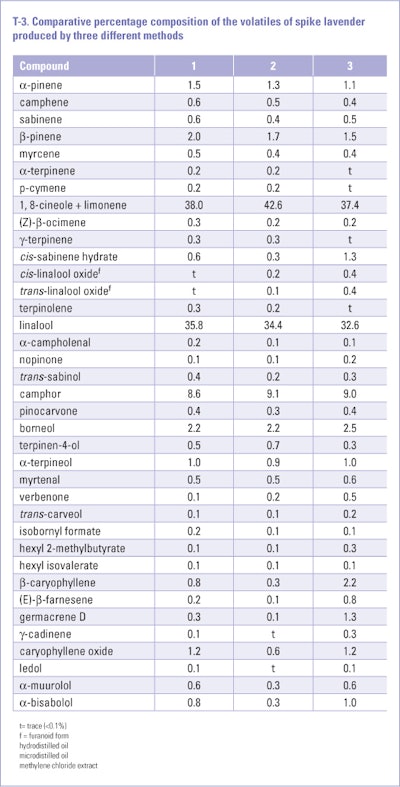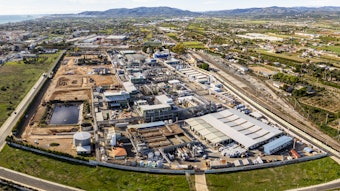
The taxonomic origin of spike lavender oil is Lavandula latifolia Medic. A survey of the published reviews on spike lavender oil (Lawrence, 1978, 1980, 1983, 1984, 1987, 1990, 1993, 2001, 2006) revealed that the constituents which were unequivocally characterized in this oil, listed in elution order from a non-polar capillary G/C column, were as follows:
α-thujene (<0.1–0.2%)
α-pinene (1.1–6.8%)
camphene (0.1–2.1%)
1-octen-3-ol (<0.1–0.1%)
sabinene (<0.1–1.6%)
β-pinene (<0.1–4.1%)
3-octanone (<0.1–0.2%)
myrcene (<0.1–0.4%)
α-phellandrene (<0.1–0.1%)
α-terpinene (<0.1–0.3%)
p-cymene (<0.1–1.4%)
limonene (0.2–3.2%)
1, 8-cineole (18.8–42.4%)
(Z)-β-ocimene (<0.1–4.2%)
(E)-β-ocimene (<0.1–1.3%)
γ-terpinene (0.1–0.6%)
cis-sabinene hydrate (0.2–0.9%)
terpinolene (0.1–0.7%)
p-cymenene (<0.1–0.2%)
linalool (11.0–53.8%)
α-thujone (<0.1–0.1%)
cis-linalool oxidef (<0.1–6.9%)
trans-linalool oxidef (<0.1–6.4%)
camphor (0.8–23.5%)
citronellal (<0.1–0.1%)
δ-terpineol (0.2–1.2%)
borneol (0.4–10.1%)
lavandulol (0.2–1.5%)
terpinen-4-ol (0.3–2.3%)
ρ-cymen-8-ol (<0.1–0.4%)
α-terpineol (0.5–10.8%)
hexyl butyrate (<0.1–0.4%)
myrtenol (0.1–0.8%)
trans-carveol (<0.1–0.1%)
nerol (<0.1–0.7%)
cis-carveol (<0.1–0.5%)
hexyl 2-methybutyrate (<0.1–0.4%)
carvone (<0.1–0.5%)
geraniol (<0.1–1.8%)
linalyl acetate (<0.1–3.4%)
bornyl acetate (<0.1–0.7%)
cuminyl alcohol (0.1–0. 2%)
lavandulyl acetate (<0.1–1.6%)
hexyl tiglate (<0.1–0.8%)
neryl acetate (<0.1–0.9%)
hexyl hexanoate (<0.1–0.2%)
β-caryophyllene (0.2–2.2%)
coumarin (<0.1–2.4%)
trans-α-bergamotene (<0.1–0.2%)
α-humulene (0.1–0.5%)
(E)-β-farnesene (<0.1–4.8%)
germacrene D (<0.1–1.0%)
(Z)-α-bisabolene (0.3–2.1%)
β-bisabolene (<0.1–0.5%)
(E)-α-bisabolene (<0.1–2.3%s)
γ-cadinene (0.1–0.8%)
δ-cadinene (<0.1–1.0%)
caryophyllene oxide (<0.1–2.4%)
T-cadinol (<0.1–0.5%)
α-cadinol (<0.1–0.2%)
α-bisabolol (<0.1–2.6%)
f = furanoid form
For comparison purposes, the data presented in the ISO Mongraph (1996) for spike lavender oil is as follows:
limonene (0.5–3.0%)
1,8-cineole (20.0–35.0%)
camphor (8.0–16.0%)
linalool (30.0–50.0%)
α-terpineol (0.5–2.0%)
linalyl acetate (t–1.5%)
(E)-α-bisabolene (0.5–2.5%)
t = trace (<0.1%)
R.ter Heide (1985) examined the headspace of Spanish spike lavender oil and characterized acetaldehyde, butanal, isobutanal, 2-methylbutanal, valeraldehyde, isovaleraldehyde, hexanal, (E)-2-hexenal, ethanol, isopropanol, isobutanol, 2-butanol, 1-penten-3-ol, 2-methyl-3-buten-2-ol, hexanol, isopropyl formate, hexyl formate, ethyl acetate, allyl acetate, 2-butyl acetate, butyl acetate, hexyl acetate, methyl butyrate, acetone, 2-butanone, 3-buten-2-one, 2-pentanone, 3-methyl-2-butanone, 3-hexanone, 2-methyl-3-pentanone, 4-methyl-2-pentanone, 2-methyl-1-penten-3-one, 3-octanone, 2-methylfuran, 3-methylfuran, 2-ethylfuran, 3-isopropylfuran, hexyl methyl ether, isoprene and toluene as headspace volatiles.
The flowering heads of spike lavender plants that were collected from the vicinity of Bizerte (Tunisia) were air-dried and subjected to steam distillation for 2½ hrs by Alatrache etal. (2007). The resulting oil that was produced in 2.4% was analyzed by GC-FID and GC/MS. The constituents characterized in this oil were:
α-thujene (0.1%)
α-pinene (0.7%)
camphene (0.7%)
sabinene (0.1%)
β-pinene (1.6%)
myrcene (1.1%)
α-phellandrene (0.3%)
δ-3-carene (0.5%)
1, 4-cineole (0.1%)
p-cymene (1.5%)
1, 8-cineole (11.7%)
(E)-β-ocimene (0.8%)
γ-terpinene (0.3%)
fenchonea (0.7%)
linalool (32.6%)
α-campholenal (0.3%)
camphor (12.4%)
isoborneol (0.1%)
lavandulol (8.7%)
terpinen-4-ol (7.7%)
α-terpineol (1.5%)
myrtenol (<0.1%)
cis-carveol (0.5%)
α-fenchyl acetatea (0.2%)
methyl carvacrola (1.9%)
linalyl acetate (1.8%)
bornyl acetate (4.2%)
carvacrola (0.2%)
terpinen-4-yl acetate (0.2%)
geranyl acetate (0.7%)
α-cubebene (0.1%)
dihydroeugenol† (0.1%)
α-ylangene (0.1%)
α-copaene (0.7%)
β-bourbonene (<0.1%)
β-elemene (2.1%)
longifolene† (0.3%)
β-cubebene (0.7%)
aromadendrene (0.3%)
β-bisabolene (0.3%)
† incorrect identification
aidentity requires corroboration
Munoz – Bertomeu et al. (2007) examined the composition of the hydrodistilled oils of spike lavender leaves and flowers that were collected from plants harvested in full flower from seven different location in Spain. The results of the analyses that were performed using GC/MS only can be seen in T-1
Eikani et al. (2008) compared the volatile composition of a hydrodistilled oil with those of a solvent extract and an extract produced by superheated water of L. latifolia,which was harvested from plants in full flower from an experimental field in Kashan (Iran). The volatiles, which were analyzed by a combination of GC/FID and GC/MS can be seen in T-2.
Williams (2008) reported that a commercial sample of spike lavender oil contained the following constituents:
α-pinene (1.9%)
camphene (0.7%)
sabinene (0.7%)
β-pinene (2.1%)
myrcene (0.5%)
limonene (0.5%)
1,8-cineole (30.7%)
(Z)-β-ocimene (0.3%)
cis-sabinene hydrate (0.9%)
linalool (36.4%)
camphor (13.1%)
borneol (0.7%)
δ-terpineol (0.3%)
terpinen-4-ol (0.5%)
α-terpineol (1.1%)
β-caryophyllene (1.3%)
(E)-β-farnesene (0.3%)
germacrene D (0.5%)
β-bisabolene (0.3%)
(E)-α-bisabolene (1.7%)
caryophyllene oxide (0.5%)
α-bisabolol (1.8%)
T-cadinol (0.3%)
In addition, trace amounts (<0.1%) of p-cymene, (E)-β-ocimene, γ-terpinene, terpinolene, cis-linalool oxide and trans-linalool oxide (furanoid forms), cryptone, linalyl acetate, hexyl butyrate, hexyl isobutyrate, hexyl 2-methylbutyrate, bornyl acetate, lavandulol and trans-α-bergamotene were also listed as constituents of this oil.
Spike lavender plants that were harvested in full flower from an experimental garden in Segeza (Foggia, Italy) were hydrodistilled (the flowers only) for 3hr by Fiocco etal. (2011). Analysis of the oil by GC-FID and GC/MS revaled that it possessed the following composition:
α-thujene (0.2%)
α-pinene (0.7%)
camphene (0.4%)
sabinene (0.3%)
β-pinene (0.6%)
3-octanone (0.2%)
myrcene (1.0%)
α-phellandrene (0.1%)
δ-3-carene (0.2%)
α-terpinene (0.1%)
p-cymene (4.7%)
1,8-cineole (11.0%)
(Z)-β-ocimene (1.3%)
(E)-β-ocimene (1.3%)
γ-terpinene (0.4%)
terpinolene (0.4%)
1-octen-3-ol (0.6%)
linalool (44.5%)
camphor (3.6%)
terpinen-4-ol (9.8%)
borneol (10.9%)
α-terpineol (0.9%)
lavandulyl acetate (1.3%)
geranyl acetate (0.7%)
β-farnesene* (0.7%)
*correct isomer not identified
The volatiles produced from spike lavender plants, that were harvested in full flower, by hydrodistillation, microdistillation and methylene chloride extraction were the subject of a study by Mendez-Tovar et al. (2015). The comparative results determined using GC-FID and GC/MS as their method of analysis can be seen in T-3. In addition trace amounts (<0.1%) of tricyclene, α-thujene, thuja-24(10)-diene, α-phellandrene, (E)-β-ocimene, cis-p-menth-2-en-1-ol, hexyl butyrate and δ-cadinene were also found in the volatiles from the three isolation procedures.













